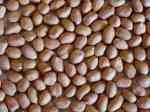Description: The peanut, or groundnut (Arachis hypogaea), is a species in the legume "bean" family (Fabaceae) native to South America, Mexico and Central America. It is an annual herbaceous plant growing 30 to 50 cm (0.98 to 1.6 ft) tall. The leaves are opposite, pinnate with four leaflets (two opposite pairs; no terminal leaflet), each leaflet 1 to 7 cm (⅜ to 2¾ in) long and 1 to 3 cm (⅜ to 1 inch) broad. The flowers are a typical peaflower in shape, 2 to 4 cm (¾ to 1½ in) across, yellow with reddish veining. After pollination, the fruit develops into a legume 3 to 7 cm (1.2 to 2.8 in) long, containing 1 to 4 seeds, which forces its way underground to mature.
Harvest: Groundnuts have a growing period of approximately 5 months. Seeding typically occurs mid-April to mid-May, and harvesting is done between August and September
Locations: In Nigeria, Groundnut is produced in almost all the northern states. The leading producing states include: Niger, Kano, Jigawa, Zamfara, Kebbi, Sokoto, Kastina, Kaduna, Adamawa, Yobe, Plateau, Bauchi, Borno, Taraba, Gombe and Nassarawa
Specification
According to Food and Agriculture Organization (FAO), Indian Standard Institute (ISI) categories groundnuts, into three grades using different specifications as stated in the table below.
Grades of groundnuts required for milling % by weight (max) | ||||
S/n | Characteristics | Grade 1 | Grade 2 | Grade 3 |
1 | Damaged and weevil kernels | 0.5 | 1.5 | 3.0 |
2 | Slightly damaged kernels | 1.0 | 2.0 | 4.0 |
3 | Shriveled and immature kernels | 1.0 | 30. | 6.0 |
4 | Split and broken kernels | 5.0 | 10.0 | 15.0 |
5 | Nooks, % by weight (max) | 1.0 | 2.0 | 3.0 |
6 | Impurities | 1.0 | 2.0 | 3.0 |
7 | Admixture with other types | 1.0 | 2.0 | 5.0 |
8 | Total of 1-7 above (max) | 6.0 | 12.0 | 30.0 |
9 | Moisture content | 6.0 | 6.0 | 6.0 |
10 | Oil content on moisture free basis | 48.8 | 46.0 | 42.0 |
11 | Acid value of extracted oil (max) | 2.0 | 4.0 | 6.0 |
Uses
1. Edible groundnuts account for two-thirds of the total groundnut use in the United States.
2. Popular confections include salted groundnuts, groundnut butter (sandwiches, candy bars, and cups), groundnut brittle, and shelled nuts (plain/roasted).
3. Salted groundnuts are usually roasted in oil and packed in retail size, plastic bags or hermetically sealed cans. Dry roasted, salted groundnuts are also marketed in significant quantities.
4. Groundnuts are often a major ingredient in mixed nuts because of their inexpensiveness compared to Brazil nuts, cashews, walnuts, and so on.
5. The primary use of groundnut butter is in the home, but large quantities are also used in the commercial manufacture of sandwiches, candy, and bakery products.
6. Boiled groundnuts are a preparation of raw, unshelled green groundnuts boiled in brine and typically eaten as a snack in the southern United States where most groundnuts are grown.
7. More recently, groundnuts can be fried, where they can be eaten both shell and nut.
8. Also groundnuts are used in cosmetics, nitroglycerin, plastics, dyes and paints
Export market: The major groundnut importers are the European Union (EU), Canada, and Japan. These three areas account for 78% of the world's imports.
Export price: Groundnut unlike cashew nut is usually exported as kernel (i.e shelled groundnut) The export free on board (fob) price of groundnut varies from about USD 800-1,100/MT depending on the grade.
Local price: The average local prices per metric tonne (MT) of the three grades of groundnuts from Kano market in Nigeria are as follows:
Grades | Local Price /MT |
Grade I | NGN119,000.00 |
Grade II | NGN116,000.00 |
Grade III | NGN110,000.00 |

how can i get a gradeII groundnut for that price this is my email address you can contact me imeldaokoro@yahoo.com
ReplyDelete